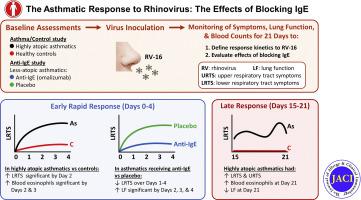Journal of Allergy and Clinical Immunology ( IF 11.4 ) Pub Date : 2020-02-01 , DOI: 10.1016/j.jaci.2020.01.035 Peter W Heymann 1 , Thomas A E Platts-Mills 2 , Judith A Woodfolk 2 , Larry Borish 2 , Deborah D Murphy 1 , Holliday T Carper 1 , Mark R Conaway 3 , John W Steinke 2 , Lyndsey Muehling 2 , W Gerald Teague 4 , Joshua L Kennedy 5 , Anne-Marie Irani 6 , Matthew D McGraw 7 , Stephen V Early 8 , Lisa M Wheatley 9 , Amy P Adams 10 , Ronald B Turner 11

|
Background
Rhinovirus frequently causes asthma exacerbations among children and young adults who are allergic. The interaction between allergen and rhinovirus-induced symptoms and inflammation over time is unclear.
Objective
Our aim was to compare the response to an experimental inoculation with rhinovirus-16 in allergic asthmatics with the response in healthy controls and to evaluate the effects of administrating omalizumab before and during the infection.
Methods
Two clinical trials were run in parallel. In one of these trials, the response to an experimental inoculation with rhinovirus-16 among asthmatics with high levels of total IgE was compared to the response in healthy controls. The other trial compared the effects of administering omalizumab versus placebo to asthmatics in a randomized, double-blind placebo-controlled investigation. The primary outcome for both trials compared lower respiratory tract symptoms (LRTSs) between study groups over the first 4 days of infection.
Results
Frequent comparisons of symptoms, lung function, and blood eosinophil counts revealed differences that were more pronounced among allergic asthmatics than among controls by days 2 and 3 after virus inoculation. Additionally, an augmentation of upper respiratory tract symptom scores and LRTS scores occurred among the atopic asthmatics versus the controls during the resolution of symptoms (P < .01 for upper respiratory symptom tract scores and P < .001 for LRTS scores). The beneficial effects of administering omalizumab on reducing LRTSs and improving lung function were strongest over the first 4 days.
Conclusions
LRTSs and blood eosinophil counts were augmented and lung function was reduced among allergic asthmatics early after rhinovirus inoculation but increased late in the infection during symptom resolution. The effect of administering omalizumab on the response to rhinovirus was most pronounced during the early/innate phase of the infection.
中文翻译:

了解对实验性鼻病毒感染的哮喘反应:探索阻断 IgE 的效果。
背景
鼻病毒经常导致过敏的儿童和年轻人的哮喘发作。随着时间的推移,过敏原和鼻病毒引起的症状和炎症之间的相互作用尚不清楚。
客观的
我们的目的是比较过敏性哮喘患者对鼻病毒 16 实验接种的反应与健康对照的反应,并评估在感染前和感染期间使用奥马珠单抗的效果。
方法
两项临床试验同时进行。在其中一项试验中,将高水平总 IgE 的哮喘患者对鼻病毒 16 实验性接种的反应与健康对照的反应进行了比较。另一项试验在一项随机、双盲、安慰剂对照研究中比较了奥马珠单抗与安慰剂对哮喘患者的影响。两项试验的主要结果在感染的前 4 天比较了研究组之间的下呼吸道症状 (LRTS)。
结果
对症状、肺功能和血液嗜酸性粒细胞计数的频繁比较显示,在病毒接种后第 2 天和第 3 天,过敏性哮喘患者的差异比对照组更为明显。此外,在症状消退期间,特应性哮喘患者与对照组相比,上呼吸道症状评分和 LRTS 评分增加(上呼吸道症状评分P < .01 ,LRTS 评分P < .001)。在前 4 天,给予奥马珠单抗对减少 LRTS 和改善肺功能的有益效果最强。
结论
在鼻病毒接种后早期,过敏性哮喘患者的 LRTS 和血液嗜酸性粒细胞计数增加,肺功能降低,但在症状消退期间感染后期增加。在感染的早期/先天阶段,给予奥马珠单抗对鼻病毒反应的影响最为明显。









































 京公网安备 11010802027423号
京公网安备 11010802027423号